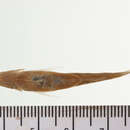pms
nòm ant ël fil


The sicklefin chub (Macrhybopsis meeki) is a species of ray-finned minnow fish in the family Cyprinidae. It is found only in the United States. It is one of the 324 fish species found in Tennessee, and is a species of concern in the Charles M. Russell National Wildlife Refuge in Montana.[2]
The type species was collected in the Missouri River near St. Louis, Missouri, and described by David Starr Jordan and Barton Warren Evermann in 1896.[3] They named it Hybopsis meeki.[3] The name meeki is in honor of Seth Eugene Meek, a noted American fish biologist.[4] In 1908, Stephen Alfred Forbes and Robert Earl Richardson suggested the binomial name Platygobio gracilis based on a specimen collected in Illinois, but this is clearly the same species described by Jordan and Evermann.[3]
The sicklefin chub is a small fish which can reach 4.25 inches (10.8 cm) in adulthood.[5] The snout is round and bulbous, and overhangs the lower jaw slightly.[4] It is fairly round and thickest around the nape (the area just in back of the head), and the body tapers significantly until it reaches the tail.[4][5] Its head is wide and deep, flat on top, with eyes set high on the head.[3][5] The eyes are not as high on the head as in similar species, and are sometimes covered with a flap of skin.[4] There is a small barbel near the corner of the mouth,[5] and small pustules on the throat.[3] Unlike the sturgeon chub, which it closely resembles, the sicklefin chub has no "keels" (small ridge-like protrusions on its scales).[5] This fish has silvery sides, and is light green or brown on top.[5] The fish often exhibits dark brown or silver specks.[5] In larger individuals, the lower lobe of the caudal fin is often black with a white edge.[6] This fish has large, pointed, sickel-shaped fins, which gives the minnow its name.[7] The dorsal fin originates just over or behind where the pelvic fin originates.[5] When depressed, the first dorsal fin extends beyond the last ray. The tip of the pelvic fin can reach beyond the origin of the pelvic fin.[7] There are eight rays in the anal fin.[5] The chest and belly of the fish lack scales, but not the sides or tail.[4]
Little is known about its feeding habits,[3] although it does have teeth in its throat.[5] Black fly pupae and other insects have been found in the stomachs of some specimens.[8] There is some evidence that it is a bottom feeder.[9][10] The eyes are weak and it does not see well.[11] Its body, however, is covered with taste buds which help it locate food.[11] There are also taste buds in the mouth, which has led to speculation that the fish sorts food orally and spits out what is not edible.[10]
Almost nothing is known about its breeding habits,[3] but it is an egg layer.[9] The sicklefin chub exhibits little sexual dimorphism, and neither sex exhibits color changes during breeding.[4] However, the male develops small tubercles on the fin rays during breeding.[4] Breeding probably occurs in the spring,[8][12] and the fish is thought to be quite short-lived.[12]
The sickelfin chub lives in fast-moving rivers with sandy or fine gravel beds,[3] but is more commonly found on sandy beds.[8] Its range covers the entire Missouri River; the Mississippi River from the mouth of the Missouri River down to the Ohio River; and the Mississippi River in southern Mississippi and northern Louisiana.[5] It is fairly common in the Missouri River, but rare elsewhere.[5] It has also been reported in the lower Kansas River.[8]
Dams have destroyed much of the sickelfin chub's habitat by slowing currents and allowing silt to precipitate from the water and cover the sand and gravel beds the fish prefers.[13] The United States Fish and Wildlife Service (FWS) estimated in 2001 that it only inhabited about 54 percent of its former range.[14] In 1993, the FWS considered listing the sickelfin chub as a threatened species, but declined to do so.[15]
The sicklefin chub (Macrhybopsis meeki) is a species of ray-finned minnow fish in the family Cyprinidae. It is found only in the United States. It is one of the 324 fish species found in Tennessee, and is a species of concern in the Charles M. Russell National Wildlife Refuge in Montana.